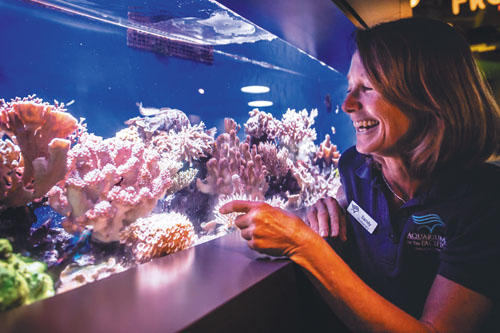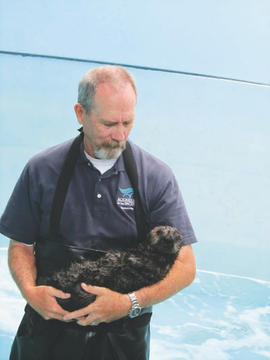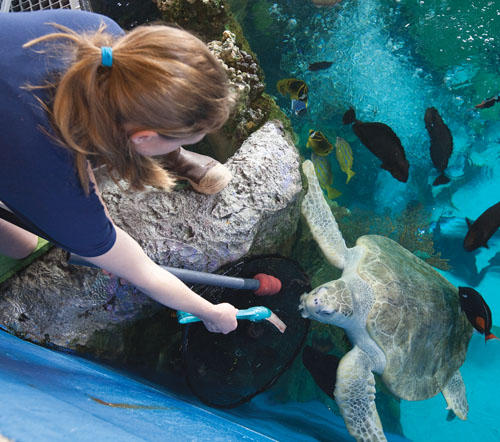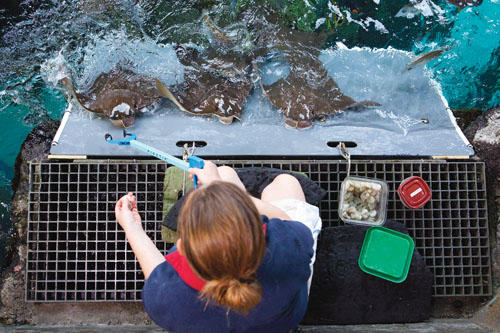The Aquarium of the Pacific houses a total of 500 species, which include fish, mammals, birds and invertebrates, according to the Aquarium’s interim vice-president of husbandry, Sandy Trautwein. To care for the animals, the Aquarium retains about 50 people in the husbandry department. These are positions that require a “jack of all trades,” Trautwein said.

Sandy Trautwein is the interim vice president of husbandry and the curator of fish and invertebrates at the Aquarium of the Pacific. According to Trautwein, the Aquarium houses a total of 500 species and employs about 50 people in the husbandry department to care for them. (Aquarium of the Pacific Photograph)
“Not only do you have to know about animal husbandry and how to best care for a species, but you also have to know about plumbing, filtration, lighting, water chemistry and diving,” she said. “It’s a multi-dimensional position that attracts a lot of people because every day is different.” Trautwein is also the curator of fish and invertebrates, which are defined as any animal without a spinal column. These can range from insects and spiders to crustaceans, squid and octopuses.
The job responsibilities of the animal care specialists include feeding the animals up to four times per day, working with them in training sessions and diving into the exhibits several times per week to clean them. The Aquarium’s smallest exhibit has about 10 gallons of water and the largest about 350,000, according to Trautwein. The animals also have a vitamin regimen, Wigdahl said. The Aquarium employs a full veterinary staff on site.
“We have to be here 365 days, seven days per week. The animals don’t know whether it’s a holiday or a vacation. They don’t have Christmas off,” the Aquarium’s curator for mammals and birds, Dudley Wigdahl, said. “This job is taken up by a lot of dedicated people who have a strong interest.”

Dudley Wigdahl, the curator of birds and mammals at the Aquarium of the Pacific, cradles a southern sea otter. The otters are one of the most popular exhibits and also an endangered species. (Aquarium of the Pacific Photograph)
According to Wigdahl, the sea lions and the sea otters are the most popular exhibits. The Aquarium offers behind-the-scenes tours in which guests can feed and learn about these animals in a more intimate setting.
“Sea lions and sea otters are the biggest winners with our guests,” Wigdahl said. “[Sea otters] are cute, and you don’t get to see them locally since they’re found north of Santa Barbara.” He noted that the southern sea otter is an endangered species, and that the Aquarium possesses two of the oldest in captivity: Brooke and Charlie, who are both 21 years old.
In addition to the sea otters, the Aquarium supports other threatened species with the aim of reintroducing them into the wild or giving them to other aquariums if needed. Trautwein said a program is underway to cultivate the white abalone, an endangered species of sea snail. The Aquarium is working with the National Oceanic and Atmospheric Administration to integrate them back into their natural habitat. Sea dragons, which are found in only one region of Australia, are another endangered species that guests have the opportunity to encounter.
The Aquarium is a member of the Association of Zoos and Aquariums (AZA), a national nonprofit organization dedicated to upholding high standards for conservation, science and recreation programs at zoos and aquariums. Through the AZA’s species survival programs, aquariums are able to trade animals if one facility has a surplus of a particular species, according to Wigdahl. The Aquarium has also acquired animals from rescue programs for animals stranded on beaches.
“Some animals can be rehabilitated and returned to the wild, but some of them can’t,” Wigdahl said. “Maybe this is due to blindness, or maybe a loss of a flipper due to a shark bite.”
Other means of acquiring animals include breeding them within the facility or obtaining a government permit to collect them from the wild. Wigdahl said the Aquarium has never had to collect them from the wild.

A sea turtle receives a meal. The animal care specialists feed the animals up to four times per day. The animal care specialists are on the job seven days per week, said the Aquarium’s curator for mammals and birds, Dudley Wigdahl. (Business Journal Photograph)
When planning an exhibit, the Aquarium staff takes into account the interests of guests as well as the message or theme they are trying to communicate, according to Trautwein. An upcoming exhibit, “Tentacles & Ink,” focuses on cephalopods, a group that includes squid, octopuses and cuttlefish. It is set to open May 25. The main theme is biodiversity of tropical environs.
“When people think of tropical environs, they think of coral reefs, but we want to celebrate other species,” Trautwein explained. “[Cephalopods] are considered the more intelligent invertebrates. We’d like to talk about how their intelligence and evolutionary strategies have allowed them to persist for so long. Now, they make up a large part of [life in] tropical reefs.”
Trautwein said that, with each exhibit, the Aquarium aims to engage the guest or offer a new perspective. Visitors have the opportunity to touch sharks and moon jellyfish. One exhibit monitors the motions of jellyfish and translates them into music.

A group of sting rays come up for food. (Business Journal Photograph)
“It’s really amazing and beautiful,” Trautwein said. “People are amazed to learn that, as these jellies pass in front of sensors . . . [they] are actually converting their movement into sound. It’s an incredible experience.”
In addition to entertaining the guests, Wigdahl explained that one of the Aquarium’s goals is to connect the experience to larger environmental themes, such as global warming, pollution and overfishing.
“When guests come in, we have an opportunity to enlighten them on things they can do from their own home, let them know the state of the world, and sensitize them to the environment,” he said. “Hopefully we can make an impact so we’re better off with the next generation.”
